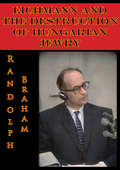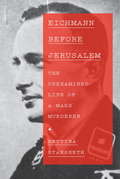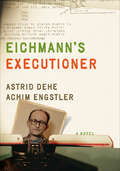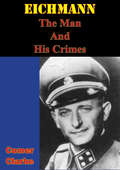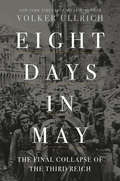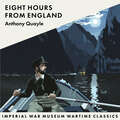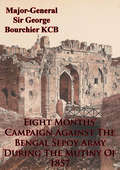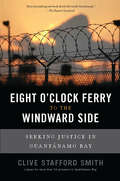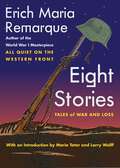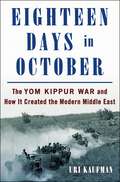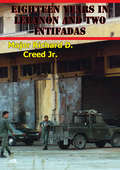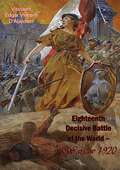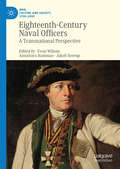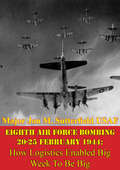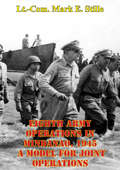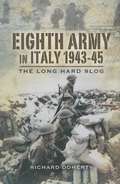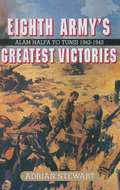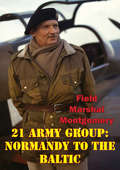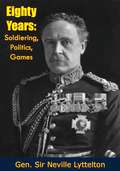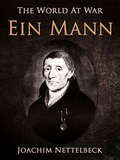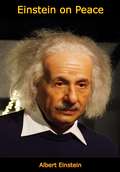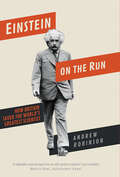- Table View
- List View
Eichmann And The Destruction Of Hungarian Jewry
by Randolph L. BrahamThe capture of Adolf Eichmann and the subsequent dispute between Israel and Argentina before the Security Council of the United Nations have aroused new interest in the history of Nazi Germany in general and of its anti-Jewish policies in particular. This interest gained momentum as the preparations for Eichmann's trial progressed.The 15 years that have elapsed since the end of World War II have brought to light a plethora of new material and made possible a more objective evaluation of the Nazi design to liquidate the Jews of Europe, euphemistically referred to as "the final solution of the Jewish question."This study has a modest aim. Its primary purpose is to present a succinct, though informative, account of the destruction of the Hungarian Jewish community during World War II, with special emphasis on the role of Eichmann and his collaborators. Its scope and coverage are limited, for, indeed, volumes would be required to write the definitive history of Hungarian Jewry during the Nazi era on the basis of the recently discovered documentary and archival material alone. Such a larger project is now under consideration.-Preface
Eichmann Before Jerusalem: The Unexamined Life of a Mass Murderer
by Ruth Martin Bettina StangnethA total and groundbreaking reassessment of the life of Adolf Eichmann—a superb work of scholarship that reveals his activities and notoriety among a global network of National Socialists following the collapse of the Third Reich and that permanently challenges Hannah Arendt’s notion of the “banality of evil.”<P> Smuggled out of Europe after the collapse of Germany, Eichmann managed to live a peaceful and active exile in Argentina for years before his capture by the Mossad. Though once widely known by nicknames such as “Manager of the Holocaust,” in 1961 he was able to portray himself, from the defendant’s box in Jerusalem, as an overworked bureaucrat following orders—no more, he said, than “just a small cog in Adolf Hitler’s extermination machine.” How was this carefully crafted obfuscation possible? How did a central architect of the Final Solution manage to disappear? And what had he done with his time while in hiding?<P> Bettina Stangneth, the first to comprehensively analyze more than 1,300 pages of Eichmann’s own recently discovered written notes— as well as seventy-three extensive audio reel recordings of a crowded Nazi salon held weekly during the 1950s in a popular district of Buenos Aires—draws a chilling portrait, not of a reclusive, taciturn war criminal on the run, but of a highly skilled social manipulator with an inexhaustible ability to reinvent himself, an unrepentant murderer eager for acolytes with whom to discuss past glories while vigorously planning future goals with other like-minded fugitives. <P> A work that continues to garner immense international attention and acclaim, Eichmann Before Jerusalem maps out the astonishing links between innumerable past Nazis—from ace Luftwaffe pilots to SS henchmen—both in exile and in Germany, and reconstructs in detail the postwar life of one of the Holocaust’s principal organizers as no other book has done.
Eichmann in Jerusalem: A Report on the Banality of Evil
by Hannah ArendtHannah Arendt's authoritative report on the trial of Nazi leader Adolf Eichmann includes further factual material that came to light after the trial, as well as Arendt's postscript directly addressing the controversy that arose over her account.
Eichmann's Executioner: A Novel
by Astrid Dehe Achim EngstlerThis acclaimed novel imagining the life of Israeli soldier Shalom Nagar explores the legacy of the Holocaust: &“A fascinating book that doesn&’t let you go&” (Neue Deutschland, Germany). In May 1962, twenty-two men gathered in Jerusalem to decide by lot who would be Adolf Eichmann&’s executioner. These men had guarded the former Nazi SS lieutenant colonel during his imprisonment and trial, and with no trained executioners in Israel, it would fall to one of them to end Eichmann&’s life. Shalom Nagar, the only one among them who had asked not to participate, drew the short straw. Decades later, Nagar is living on the outskirts of Tel Aviv, haunted by his memory of Eichmann. He remembers watching him day and night, the way he ate, the way he slept—and the sound of the cord tensing around his neck. But as he tells and re-tells his story to anyone who will listen, he begins to doubt himself. When one of his friends, Moshe, reveals his link to Eichmann, Nagar is forced to reconsider everything he has ever believed about his past. In the tradition of postwar trauma literature that includes Günter Grass&’s The Tin Drum and Bernhard Schlink&’s The Reader, Eichmann&’s Executioner raises provocative questions about how we represent the past, and how those representations impinge upon the present. &“Both curiously transparent and full of secrets, a simultaneously dense yet airy fabric of cryptic threads and references. . . . Nothing is gratuitous in this book, nothing coincidental; all is intricately interlaced.&” —Frankfurter Rundschau, Germany
Eichmann, The Man And His Crimes: The Man And His Crimes
by Comer ClarkeEichmann’s crimes, so monstrous that the first accounts were dismissed as anti-German propaganda, resulted in the death of 6,000,000 men, women and children. To maintain secrecy, the Nazis gave him the rank of sergeant at the very time when he was supervising the murder of Austria’s Jews. Speaking Yiddish fluently, Eichmann often disguised himself as a Jew and deceived Jewish leaders into giving him the names of his future victims. In his extermination camps, Jews were forced to aid in the slaughter of their people. To those who cooperated he promised “decent burial.” Human life meant nothing to Eichmann; instead, he prided himself on the efficient operation of his death camps and spent months searching for a low-cost poison for his gas chambers.Comer Clarke, British correspondent, has spent much of the last two years in Germany and Austria, questioning war criminals and men behind the Nazi plans and terror. He has had access to secret S.S. dossiers and Nazi documents captured after the war. He has met men who knew Eichmann intimately, and traced the Nazi butcher’s activities in a blood-stained trail of murder that leads across Europe. Out of his investigations he has written EICHMANN: THE MAN AND HIS CRIMES, a full account of Eichmann’s monstrous past, his mysterious disappearance.
Eight Days in May: The Final Collapse Of The Third Reich
by Volker UllrichThe best-selling author of Hitler: Ascent and Hitler: Downfall reconstructs the chaotic, otherworldly last days of Nazi Germany. In a bunker deep below Berlin’s Old Reich Chancellery, Adolf Hitler and his new bride, Eva Braun, took their own lives just after 3:00 p.m. on April 30, 1945—Hitler by gunshot to the temple, Braun by ingesting cyanide. But the Führer’s suicide did not instantly end either Nazism or the Second World War in Europe. Far from it: the eight days that followed were among the most traumatic in modern history, witnessing not only the final paroxysms of bloodshed and the frantic surrender of the Wehrmacht, but the total disintegration of the once-mighty Third Reich. In Eight Days in May, the award-winning historian and Hitler biographer Volker Ullrich draws on an astonishing variety of sources, including diaries and letters of ordinary Germans, to narrate a society’s descent into Hobbesian chaos. In the town of Demmin in the north, residents succumbed to madness and committed mass suicide. In Berlin, Soviet soldiers raped German civilians on a near-unprecedented scale. In Nazi-occupied Prague, Czech insurgents led an uprising in the hope that General George S. Patton would come to their aid but were brutally put down by German units in the city. Throughout the remains of Third Reich, huge numbers of people were on the move, creating a surrealistic tableau: death marches of concentration-camp inmates crossed paths with retreating Wehrmacht soldiers and groups of refugees; columns of POWs encountered those of liberated slave laborers and bombed-out people returning home. A taut, propulsive narrative, Eight Days in May takes us inside the phantomlike regime of Hitler’s chosen successor, Admiral Karl Dönitz, revealing how the desperate attempt to impose order utterly failed, as frontline soldiers deserted and Nazi Party fanatics called on German civilians to martyr themselves in a last stand against encroaching Allied forces. In truth, however, the post-Hitler government represented continuity more than change: its leaders categorically refused to take responsibility for their crimes against humanity, an attitude typical not just of the Nazi elite but also of large segments of the German populace. The consequences would be severe. Eight Days in May is not only an indispensable account of the Nazi endgame, but a historic work that brilliantly examines the costs of mass delusion.
Eight Hours From England: Imperial War Museum Wartime Classics
by Anthony QuayleAutumn 1943. Realising that his feelings for his sweetheart are not reciprocated, Major John Overton accepts a posting behind enemy lines in Nazi-Occupied Albania. Arriving to find the situation in disarray, he attempts to overcome geographical challenges and political intrigues to set up a new camp in the mountains overlooking the Adriatic.As he struggles to complete his mission amidst a chaotic backdrop, Overton is left to ruminate on loyalty, comradeship and his own future.Based on Anthony Quayle's own wartime experience with the Special Operations Executive (SOE), this new edition of a 1945 classic includes a contextual introduction from IWM which sheds new light on the fascinating true events that inspired its author.(P)2019 Headline Publishing Group Ltd
Eight Months’ Campaign Against The Bengal Sepoy Army During The Mutiny Of 1857 [Illustrated Edition]
by Major-General Sir George Bourchier KCB[Illustrated with over one hundred maps, photos and portraits, of the battles, individuals and places involved in the Indian Mutiny]"The Indian Mutiny from the siege of Delhi to the mutineers' defeat at Cawnpore, via the relief of Lucknow. Written by an officer of the British Horse Artillery.An account of the Indian Mutiny in 1857 by a British participant. The author, Col. Bourchier of the Bengal Horse Artillery, describes the British siege and storming of Delhi - including the foiling of a fiendish plan to intoxicate the besieging forces; the defeat of the mutineers at Agra; the siege and massacre at Cawnpore; the relief of Lucknow by Havelock and Outram and its second relief by Sir Colin Campbell; and finally the defeat of the Gwalior mutineers at Cawnpore. An action-packed account of eight months' of remorseless fighting."-Print Ed.
Eight O'Clock Ferry to the Windward Side: Seeking Justice in Guantánamo Bay
by Clive Stafford SmithEvery time human rights lawyer Clive Stafford Smith lands in Cuba, he takes the eight o'clock ferry to the windward side; his journey ends at Guantánamo Bay. One of the few people in the world who has ongoing independent access to the prison, Smith reveals the grotesque injustices that are perpetrated there in the name of national security-including the justifications created to legitimate the use of torture and the bureaucratic structures that have been put in place to shield prison authorities from legal accountability. <P><P>By bearing witness to the stories of the forty prisoners that he represents, Smith asks us to consider what is done to American democracy when the rule of law is jettisoned in the name of combating terrorism.
Eight Stories: Tales of War and Loss (Washington Mews #3)
by Erich Maria Remarque Maria Tatar Larry WolffA compelling set of short stories chronicling post-World War I life in Germany, from the author of the classic, All Quiet on the Western Front. German-American novelist Erich Maria Remarque captured the emotional anguish of a generation in his World War I masterpiece, All Quiet on the Western Front, as well as in an impressive selection of novels, plays, and short stories. This exquisite collection revives Remarque&’s unforgettable voice, presenting a series of short stories that have long ago faded from public memory. From the haunting description of an abandoned battlefield to the pain of losing a loved one in the war to soldiers&’ struggles with what we now recognize as PTSD, the stories offer an unflinching glimpse into the physical, emotional, and even spiritual implications of World War I. In this collection, we follow the trials of naïve war widow Annette Stoll, reflect on the power of small acts of kindness toward a dying soldier, and join Johann Bartok, a weary prisoner of war, in his struggle to reunite with his wife. Although a century has passed since the end of the Great War, Remarque&’s writing offers a timeless reflection on the many costs of war. Eight Stories offers a beautiful tribute to the pain that war inflicts on soldiers and civilians alike, and resurrects the work of a master author whose legacy—like the war itself—will endure for generations to come.
Eight Survived: The Harrowing Story of the USS Flier and the Only Downed World War II Submariners to Survive and Evade Capture
by Douglas A. CampbellOn the night of August 13, 1944, the U.S. submarine Flier struck a mine in the Sulu Sea in the southern Philippines as it steamed along the surface. All but fifteen of the more than eighty-strong crew went down with the vessel. Of those left floating in the dark, eight survived by swimming for seventeen hours before washing ashore on an uninhabited island. The story of the Flier and its eight survivors is wholly unique in the annals of U.S. military history.Eight Survived tells the gripping story of the doomed submarine and its crew from its first patrol, during which it sank several enemy ships, to the explosion in the Sulu Sea. Drawing on interviews with the survivors and on a visit to the jungle where they washed ashore—where a cast of fascinating characters helped the U.S. sailors evade the Japanese—Douglas Campbell fully captures the combination of extraordinary courage and luck that marked one of the most heroic episodes of World War II.
Eighteen Days in October: The Yom Kippur War and How It Created the Modern Middle East
by Uri Kaufman"[Kaufman] tells the story brilliantly. Anyone interested in the Middle East or military history will appreciate Kaufman’s work."—Senator Joseph I. Lieberman "Stimulating and insightful...will no doubt find a permanent place on the Arab-Israeli bookshelf."—Michael Oren, New York Times bestselling author of Six Days of WarOctober 2023 marks the 50th anniversary of the Yom Kippur War, a conflict that shaped the modern Middle East. The War was a trauma for Israel, a dangerous superpower showdown, and, following the oil embargo, a pivotal reordering of the global economic order. The Jewish State came shockingly close to defeat. A panicky cabinet meeting debated the use of nuclear weapons. After the war, Prime Minister Golda Meir resigned in disgrace, and a 9/11-style commission investigated the “debacle.”But, argues Uri Kaufman, from the perspective of a half century, the War can be seen as a pivotal victory for Israel. After nearly being routed, the Israeli Defense Force clawed its way back to threaten Cairo and Damascus. In the war’s aftermath both sides had to accept unwelcome truths: Israel could no longer take military superiority for granted—but the Arabs could no longer hope to wipe Israel off the map. A straight line leads from the battlefields of 1973 to the Camp David Accords of 1978 and all the treaties since. Like Michael Oren’s Six Days of War, this is the definitive account of a critical moment in history.
Eighteen Years In Lebanon And Two Intifadas: The Israeli Defense Force And The U.S. Army Operational Environment
by Major Richard D. Creed Jr.This monograph determined that the tactical and strategic experience of the Israeli Defense Force (IDF) since 1981 was relevant to the future operational environment of the U.S. Army. The IDF's experiences are relevant because the Israeli Army was similarly equipped and organized to the heavy units in the U.S. Army, both then and now. Israel faced a similar full spectrum threat, and the IDF had to adapt to enemies who switched to asymmetric methods in order to overcome Israel's conventional military superiority. The IDF of 1981 paralleled the U.S. Army of the 2000 in many ways. It was a mechanized heavy force designed to conduct operations against a Soviet armed and equipped enemy. It fought and defeated some of those enemies decisively eight years previously. Beginning with the invasion of Lebanon (Operation "Peace for Galilee"), the IDF discovered that there were no peer competitors willing to fight it on its own terms. The nature of war changed for the IDF in sometimes unexpected ways, and it struggled to adapt to its changing operational environment. The IDF operational environment became much more complicated, because while it retained the old threats in the form of its Arab neighbors, it added sustained guerrilla war and civil insurrection.
Eighteenth Decisive Battle of the World – Warsaw 1920
by Viscount Edgar Vincent D'AbernonAfter the cataclysmic events of the First World War officially ended on the Western Front in 1918, the Democratic Western Powers were still faced with the fallout of the struggle for power in Russia. There was a very real chance that the Communist contagion would transfer across the borders of Russia to Eastern Europe, as it would do some two decades later. Viscount Edgar Vincent D'Abernon was head of the Interallied Mission to Poland and was eye-witness to the struggle in Poland that culminated in the battle for Warsaw that saw the red tide turned back.“The 18th most decisive battle in history...Had the Battle of Warsaw ended with a Bolshevik victory, it would have been a turning point in the history of Europe; as there is no doubt that with the fall of Warsaw, Central Europe would have been left open to Communist propaganda and Soviet invasion.
Eighteenth-Century Naval Officers: A Transnational Perspective (War, Culture and Society, 1750 –1850)
by Evan Wilson AnnaSara Hammar Jakob SeerupThis book surveys the lives and careers of naval officers across Europe at the height of the age of sail. It traces the professionalization of naval officers by exploring their preparation for life at sea and the challenges they faced while in command. It also demonstrates the uniqueness of the maritime experience, as long voyages and isolation at sea cemented their bond with naval officers across Europe while separating them from landlubbers. It depicts, in a way no previous study has, the parameters of their shared experiences—both the similarities that crossed national boundaries and connected officers, and the differences that can only be seen from an international perspective.
Eighth Air Force Bombing 20-25 February 1944: How Logistics Enabled Big Week To Be Big
by Major Jon M. Sutterfield USAFEighth Air Force (8AF) conducted the US's first thousand-bomber raids against Germany in February 1944--recorded in history as Big Week. Until that time the USAAF was not able to concentrate such firepower on the enemy in such a short period of time. It took much effort to make Big Week "big" covering the spectrum of planning and execution activities dating back to the end of World War I that were adapted and flexed to be successful in a different context. Indeed, the depth and breadth of the preparations required to successfully execute Big Week on the scale intended is deserving of a closer examination.Leadership from President Roosevelt to first line supervisors influenced 8AF logistics before February 1944. Major General Hugh J. Knerr was the one man that stood out as the champion of USAAF logistics. He influenced the concept of logistical operations in the ETO and, more specifically, put logistics on a level of importance equal to that of operations within the United States Strategic Air Forces (USSTAF). He synchronized logistics with operations and strove for constant improvement by making organizational and process changes aimed at increasing logistical responsiveness, effectiveness, and efficiency.The British provided tremendous host nation support including construction of new airfields, skilled and unskilled labor support, supply items, and transportation. The British host nation support 8AF received far surpassed what a cursory review of World War II history leads one to believe and serves as a model for US-led coalition operations in the 21st century. The US Merchant Marine and US Navy provided sealift of goods from the stateside depots to the theater. The US Army provided supply support of common items and Air Service Command (ASC) provided technical and supply support. Last, but not least, both civil servants and civilian contractors provided depot maintenance and in-theater technical support.
Eighth Army Operations In Mindanao, 1945 A Model For Joint Operations
by Colonel Joseph G. Terry Jr.While amphibious operations have historically straddled single service prerogatives and had been conspicuously avoided prior to World War II, in the Pacific area of operations during World War II such operations were abundant, decisive and generally regarded as models of joint service cooperation. Under the legendary General Douglas MacArthur, the Philippine Campaign in 1944-45 was especially noteworthy as a model of a single flexible strategy, unity of command, and joint service cooperation. Yet forty-five years later, our national military experience in joint planning and operations has appeared to regress. The recent Goldwater-Nichols Department of Defense Reorganization Act of 1986, however, has elevated service interest in joint planning and operations. This study briefly discusses the Mindanao Operation (March-July 1945), one of several operations within the Philippine Campaign. The study focuses on the impact of existing joint doctrine on the planning, coordination and execution of operations and evidence of joint action to solve some specific and unique challenges encountered within the operation. A summary of the Mindanao operation and appropriate comments on its applicability as a model for today's joint operations complete this study.
Eighth Army in Italy, 1943-45: The Long Hard Slog
by Richard DohertyEighth Army, Britain's most famous field army of the twentieth century, landed in Italy in September 1943 and fought continously until the defeat of the Germans in early-May 1945. This book studies the experience of Eighth Army in the Italian campaign, examining how a force accustomed to the open spaces of North Africa adjusted to the difficult terrain of Italy where fighting became much more a matter for the infantry than for the armour. It also compares the qualities of the commanders of Eighth Army in Italy: Montgomery; Leese and, finally, McCreery. The book uses official records at various levels, personal accounts - some never before published - and published material to present a picture of an army that, although defined as British, was one of the war's most cosmopolitan formations. Its soldiers came from the UK, Canada, India, Ireland, Nepal, New Zealand, Poland and South Africa as well as from Palestine - the Jewish Brigade - and from Italy itself.
Eighth Army's Greatest Victories: Alam Halfa to Tunis 1942–1943
by Adrian TurnerTo read many accounts, it would appear that the Eighth Army's victory at El Alamein was quickly followed by its triumphant arrival at Tunis. Adrian Turner, the experienced authority on the period, redresses the imbalance by describing brilliantly the progress of this legendary fighting force and describing the ferocity of such battles as that for the Mareth Line. The author deftly handles strategic level thinking, the tactical battles and individual contributions. Aviation readers will be thrilled by recognition of the Desert Air Force's contribution, too often neglected.
Eighth Army: El Alamein To The River Sangro [Illustrated Edition] (Memoirs Of Field Marshal Montgomery #2)
by Field Marshal Viscount Bernard Law Montgomery of Alamein KG GCB DSO PC[Illustrated with 16 highly detailed maps of the actions]Field Marshal Montgomery commanded the Eighth Army from 13th August 1942 until the 31st December 1943, and the 21st Army Group from 1st January 1944 until the German surrender on the 5th May, 1945. Whilst in command of the British Army of the Rhine, in occupation of Germany, shortly after the end of the Second World War Montgomery set out to record the exploits and victories of the troops under his command.Both this volume and its companion volume, Normandy to the Rhine, are superb examples of military history as presented by one of the greatest generals to command victorious armies in the field. The texts are taken from his personal war diaries and are distinguished by his incisive style. The whole strategy and course of these two campaigns are presented to the reader with great clarity and accuracy.El Alamein to the River Sangro is as he himself writes '... an authoritative account of the activities of the Eighth Army in the days of its greatest, successes'. El Alamein was the turning point in the war: from that momentous battle the tide against Germany turned. During the time the Eighth Army was commanded by Monty it lost not a single action, and when Monty was transferred to Europe in December 1943, Winston Churchill wrote to him: 'The immortal march of the Eighth Army from the gates of Cairo along the African shore, through Sicily, has now carried its ever victorious soldiers far into Italy towards the gates of Rome. The scene changes and vastly expands. A great task accomplished gives place to a greater, in which the same unfailing spirit will win for all true men a full and glorious reward.'
Eighty Years: Soldiering, Politics, Games
by Gen. Sir Neville LytteltonBegun in 1914 and first published in 1927, these are the memoirs of General Sir Neville Gerald Lyttelton, a British Army officer who served, in the Sudan, Ireland and most notably the Second Boer War. He draws upon his reminiscences with the aid of correspondence with various members of his family and from his diary entries dating back as far as 1873.A fascinating military history read!
Ein Mann: Des Seefahrers Und Aufrechten Bürgers Joachim Nettelbeck Wundersame Lebensgeschichte (The World At War)
by Joachim NettelbeckJoachim Christian Nettelbeck (* 20. September 1738 in Kolberg; 29. Januar 1824 ebenda) war ein durch seine Rolle bei der Verteidigung Kolbergs im Jahre 1807 und seine Autobiographie bekannter deutscher Volksheld. Als Elfjähriger durfte Nettelbeck auf dem Schiff seines Onkels ausnahmsweise nach Amsterdam mitreisen. Dort schlich er sich im Hafen an Bord eines holländischen Ozeanseglers und kam erst auf offener See wieder zum Vorschein. Das Schiff war ein Sklavenhändler und befuhr das Dreieck Westeuropa - Westafrika - Westindien - Westeuropa. Nach neunmonatiger Reise besuchte Nettelbeck bis zur Konfirmation wieder die Schule in Kolberg. Danach begann er eine Seemannsausbildung, zunächst als Schiffsjunge auf Ost- und Nordseefahrern. (Auszug aus Wikipedia)
Eine globale Geschichte von Kriegsführung und Technologie: Von Schleudern zu Robotern
by Kaushik RoyDieses Buch behandelt die globale Geschichte von Technologie, Kriegsführung und Staatenbildung vom Steinzeitalter bis zum Informationszeitalter. Unter Verwendung einer Kombination von Top-Down- und Bottom-Up-Methoden untersucht es sowohl zwischenstaatliche als auch innerstaatliche Konflikte mit einem Schwerpunkt auf eurasischer Technologie und Kriegsführung. Es zeigt, wie menschliches Handeln und strukturelle Faktoren miteinander verflochten sind und ein komplexes Geflecht von Technologie und Kriegsführung schaffen. Es erforscht auch das Zusammenspiel zwischen technologischen und nicht-technologischen Faktoren, um die Entwicklung der Kriegsführung von ihren Anfängen bis heute zu veranschaulichen, und argumentiert, dass die Interaktionen zwischen zivilen und militärischen Sektoren den Einsatz von Technologie in der Kriegsführung geprägt haben. Aufgrund ihres Umfangs und ihrer Tiefe ist es eine wertvolle Ressource für Forscher in Bereichen wie Weltgeschichte, Geschichte von Wissenschaft und Technologie, Geschichte von Kriegsführung und Imperialismus sowie Internationale Beziehungen.
Einstein on Peace: His Private Thoughts And Public Stands On Nationalism, Zionism, War, Peace, And The Bomb
by Albert Einstein Otto Nathan“Einstein was not only the ablest man of science of his generation, he was also a wise man, which is something different. If statesmen had listened to him, the course of human events would have been less disastrous than it has been.”This verdict, from the Preface by Bertrand Russell, sums up the importance of this first collection of Albert Einstein’s writings on war, peace, and the atom bomb. In this volume, thanks to the Estate of Albert Einstein, the complete story is told of how one of the greatest minds of modern times worked from 1914 until 1955 on the problem of peace. It is a fascinating record of a man’s courage, his sincerity, and his concern for those who survive him.This book is also a history of the peace movement in modern times. Here are letters to and from some of the most famous men of his generation, including the correspondence between Einstein and Sigmund Freud on aggression and war, and the true story of his famous letter to President Roosevelt reporting the theoretical possibility of nuclear fission. It is the living record of more than forty years of Einstein’s untiring struggle to mobilize forces all over the world for the abolition of war and the creation of a supranational organization to solve conflicts among nations.
Einstein on the Run: How Britain Saved the World's Greatest Scientist
by Andrew RobinsonA "highly readable" account of the role Britain played in Einstein's life—by inspiring his teenage passion for physics and providing refuge from the Nazis (The Wall Street Journal).In late 1933, Albert Einstein found himself living alone in an isolated holiday hut in rural England. There, he toiled peacefully at mathematics, occasionally stepping out for walks or to play his violin. But how had Einstein come to abandon his Berlin home and go “on the run”?This lively account tells the story of the world’s greatest scientist’s time in Britain for the first time, showing why the country was the perfect refuge for Einstein from rumored assassination plots by Nazi agents. Young Einstein’s passion for British physics, epitomized by Newton, had sparked his scientific development around 1900. British astronomers had confirmed his general theory of relativity, making him internationally famous in 1919. Welcomed by the British people, who helped him campaign against Nazi anti-Semitism, he even intended to become a British citizen. So why did Einstein then leave Britain, never to return to Europe?“A vivid look at how the U.K. affected the German-born physicist’s life and thinking.” —Publishers Weekly“A marvelous job of pulling new and interesting material out of the Einstein archives . . . I suspect that even readers who have devoured many books about Einstein and are already familiar with his interactions with the English . . . will find much to learn and enjoy.” —Metascience Journal“Robinson has that rare knack for presenting a near-encyclopedic volume of historical information, anecdotes and contemporaneous accounts in a thoroughly delightful fashion.” —Physics WorldIncludes photographs and illustrations
